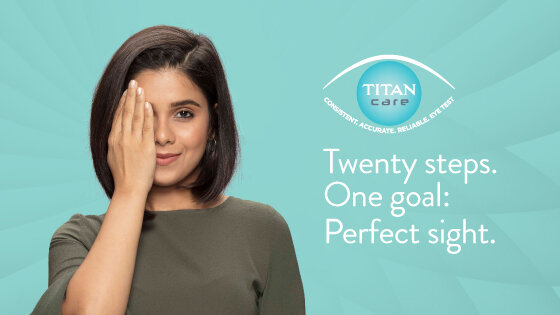Everything you need to know…
There are more than a dozen factors contributing to good eyesight. And many a time, early symptoms of vision defects go unnoticed. Which is why, we have a comprehensive, extensively detailed eye test that comprises of 20 elaborate steps. We make sure that every aspect of your eye is examined and assessed by our well-trained optometrists. Here’s how the 20 steps go & why exactly each one of them is important!
Step 1- Getting an in-depth understanding of prevailing symptoms
The optometrist understands the symptoms or problems faced by the customer to form a tentative diagnosis.

Step 2- History recording of the customer
A general enquiry will be made about the customer’s overall health and earlier treatments, surgeries or eye check-ups, if any to make the most accurate conclusions on the customer’s eye health.

Step 3- Ocular examination with a torch
The optometrist inspects for abnormalities in the eyes and observes pupillary reactions, & records findings.

Step 4- Previous prescription check
Spectacles are checked for power, centration and defects that may be presently affecting the customer’s vision, possibly causing discomfort or vision-related unease.

Step 5- Vision check
The vision of each eye is checked & recorded for distant and near vision.

Step 6- Extraocular movement test
The functionality of six muscles of the eye will be tested in this step of the test to gauge the overall health of the customer’s eyes.

Step 7- Cover test- Phoria and Tropia
The Cover Test determines if the alignment of the eyes is proper & identifies the type of squint, if any is discovered in the customer.

Step 8- Convergence test
The optometrist checks the ability of the eyes to converge on a nearby object, ensuring clarity of near vision.

Step 9- Objective refraction by auto-refractometer/ retinoscope
Computerized power checking is done to estimate refractive errors to determine if you have myopia, hypermetropia, presbyopia or astigmatism, thereby identifying where the vision-related problem originates.

Step 10- JCC/Clock dial test for axis
Helps in discovering the right cylindrical axis so that the customer enjoys the most precise vision.

Step 11- JCC/clock dial test for cylindrical power
Helps in determining precise cylindrical power.

Step 12- Fogging test
Allows the optometrist to determine refractive errors by controlling accommodation.

Step 13- Duo-chrome test
Helps in determining accurate spherical power so under or over correction can be verified.

Step 14-Binocular balancing test
Detects if the accommodation has been at rest or balanced for both the eyes.

Step 15- Measuring working distance
A test for people with presbyopia, which determines the working distance required by the customer for reading or any other day-to-day activity.

Step 16- Final near-power calculation
A test for people with presbyopia where the optometrist considers the customer’s old near-power, lifestyle & working distance to calculate & arrive at the right near-power for current comfort.

Step 17- Slit lamp examination
Checks the anterior parts of the eye & detects abnormalities (like cataract, corneal opacities etc.), if any.

Step 18- Colour vision test
Conducted to rule out the condition of colour blindness.

Step 19- Final Rx
All the test results are correlated to arrive at the final power required to help the customer see with ease.

Step 20- Counselling & advice
The optometrists explain the outcome in simple language to the customer & give suggestions to improve eye health.




